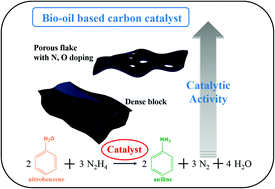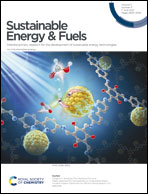Carbon materials derived from polymerization of bio-oil as a catalyst for the reduction of nitrobenzene†
Abstract
Bio-oil is a condensable liquid obtained from pyrolysis of biomass, which is the feedstock not only for the production of biofuels, but also for the production of functional carbon materials. In this study, carbon materials derived from the polymerization of bio-oil and furfural were treated with varied methods and were used as catalysts for the reduction of nitrobenzene to aniline with hydrazine hydrate as a reductant. The results showed that the oxidation of carbon materials with HNO3 formed more C![[double bond, length as m-dash]](https://www.rsc.org/images/entities/char_e001.gif) O and C
O and C![[double bond, length as m-dash]](https://www.rsc.org/images/entities/char_e001.gif) N functionalities, and created some defects, while the doping with urea led to the elimination of the carbonyl functionalities. The presence of N species in the carbon materials changed the electronic state of the carbon atom and induced the skeleton expansion of the graphite structure in the carbon materials, creating remarkably more defect sites than from the oxidation with HNO3. These defective structures were essential for endowing the carbon materials with superior catalytic activity and stability for the selective reduction of nitrobenzene to aniline.
N functionalities, and created some defects, while the doping with urea led to the elimination of the carbonyl functionalities. The presence of N species in the carbon materials changed the electronic state of the carbon atom and induced the skeleton expansion of the graphite structure in the carbon materials, creating remarkably more defect sites than from the oxidation with HNO3. These defective structures were essential for endowing the carbon materials with superior catalytic activity and stability for the selective reduction of nitrobenzene to aniline.



 Please wait while we load your content...
Please wait while we load your content...